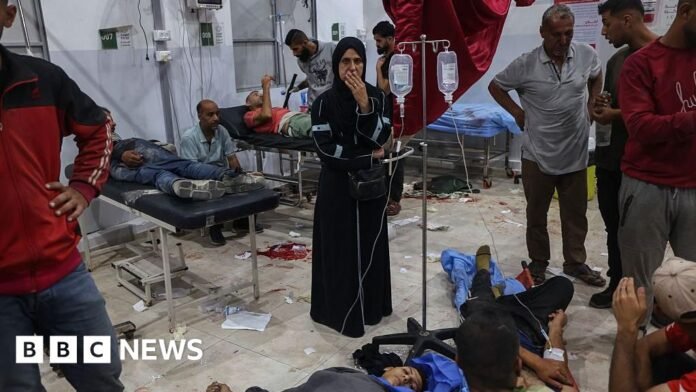Middle East correspondent
 AFP
AFPAt least 46 people waiting for aid have been killed by Israeli fire in two incidents in central and southern Gaza, according to rescuers and hospitals.
UN agencies have condemned the US and Israel-backed food distribution system, with one official calling it “an abomination” and “a death trap”.
Such deadly incidents have recently become a near daily occurrence but have attracted relatively little attention outside Gaza since Israel attacked Iran more than a week ago.
Without including the latest deaths, the UN has said that more than 410 Palestinians are reported to have been killed by Israeli gunfire or shelling since the Gaza Humanitarian Foundation (GHF) began work in late May.
“Why are our children’s lives seen as so cheap?” demanded Umm Raed al-Nuaizi, a widow whose son was shot and wounded after he went overnight to collect food for his hungry family in central Gaza.
“My son went to get a grain of flour so that he could eat and feed his siblings, and now he is in the intensive care unit.”
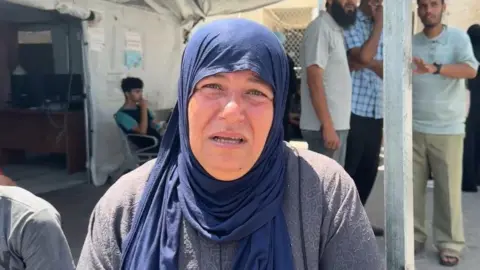
Footage from al-Awda hospital in Nuseirat showed chaotic scenes as young men with gunshot wounds were carried in, groaning in pain and some drenched in blood.
Soon every bed was filled, and casualties covered the floor.
An older man was set down dead as his wife, bereft, cradled his face and wept.
Hospital officials and the Hamas-run Civil Defence agency said that at least 21 people were killed and some 150 injured.
Witnesses said that thousands had crowded near a site run by the GHF in an Israeli military zone when soldiers opened fire.
The Israel Defense Forces (IDF) said a gathering had been “identified in an area adjacent to IDF troops operating in the Netzarim corridor”.
“Reports of injured individuals as a result of IDF fire in the area were received. The details are under review,” it stated.
The GHF said there were “no incidents near any of our sites this morning”.
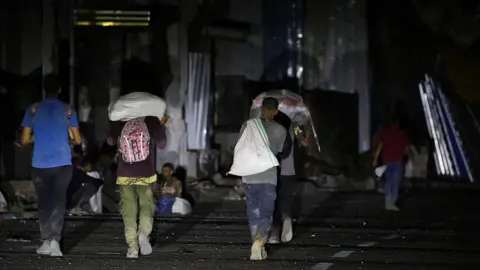 AFP
AFPParamedics and rescuers said that at least 25 people were also killed near a site run by the GHF in southern Gaza on Tuesday morning.
A witness told the BBC that he had gone to a site north of Rafah at 05:00, but shortly before it was due to open at 10:00, Israeli tanks advanced towards them and opened fire with no announcements.
“The shooting was directly on the civilians and blood got everywhere,” Hatem Abu Rjileh said.
“Everyone around us got wounded, there may be more than 30 wounded whom no-one was able to rescue. We only managed to rescue our relative and left with him.”
The IDF told the BBC that “contrary to the reports being spread out, the IDF is not aware of the incident in question at the Rafah aid distribution site”.
Israel eased its total blockade of Gaza just over a month ago, and the GHF began operations a few days later. The group says it has since provided 41 million meals.
While GHF is officially classed as a private organisation, it has opaque funding and is backed by the US and Israel. It uses armed private security contractors.
The UN and major aid groups have refused to co-operate with the foundation, accusing it of co-operating with Israel’s goals in the 20-month-old war against Hamas in a way that violates humanitarian principles.
However, Israel sees the GHF as key to a new aid plan which it says will undermine what remains of Hamas control in Gaza.
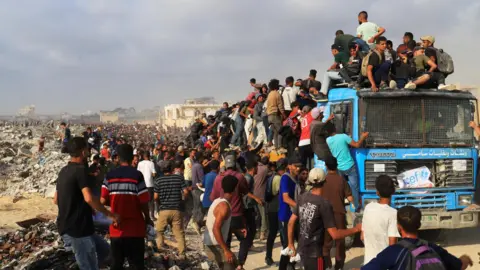 Reuters
ReutersAs news of the latest incidents broke, a spokesman for the UN human rights office, Thameen al-Kheetan, held a briefing in Geneva condemning the system.
“Israel’s militarised humanitarian assistance mechanism is in contradiction with international standards on aid distribution,” he said.
“The weaponization of food for civilians, in addition to restricting or preventing their access to life-sustaining services constitutes a war crime.”
He added that it was for courts to decide if war crimes had been committed.
Speaking to reporters in Berlin, Philippe Lazzarini, the head of the UN agency for Palestinian refugees (Unrwa), said: “The newly created, so-called mechanism is an abomination that humiliates and degrades desperate people. It is a death trap costing more lives than it saves.”
Asked for a response to recent UN criticism, the IDF told the BBC that it allowed the GHF “to operate independently in distributing aid to the residents of Gaza and is working to ensure its safe and continuous distribution, in accordance with international law”.
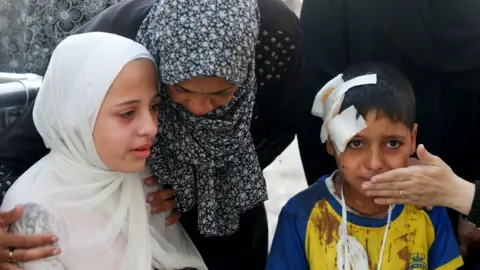 Reuters
ReutersIsrael’s idea for a new phase of war in Gaza, put forward several weeks ago, has not taken place.
This involved the GHF running the only aid distribution points.
For now, Israel is still allowing dozens of lorries carrying aid for the UN and some other aid organisations into Gaza.
On Saturday, World Central Kitchen said aid lorries had reached its teams in Gaza for the first time in over 12 weeks, allowing it to restart cooking at some of its sites.
However, the volume of food is still inadequate, and experts warn that Gaza remains on the brink of famine.
In Gaza City, a father of four daughters told us that his family had resorted to eating bread and salt but that he would not risk his life to go to the GHF aid centres.
“They are called death zones,” Mahmoud al-Ghura said. “My son has already been martyred.”
“I am afraid that if I went to get a bag of flour I would return carried in one. Every day people go there and die. What are we to do?”



